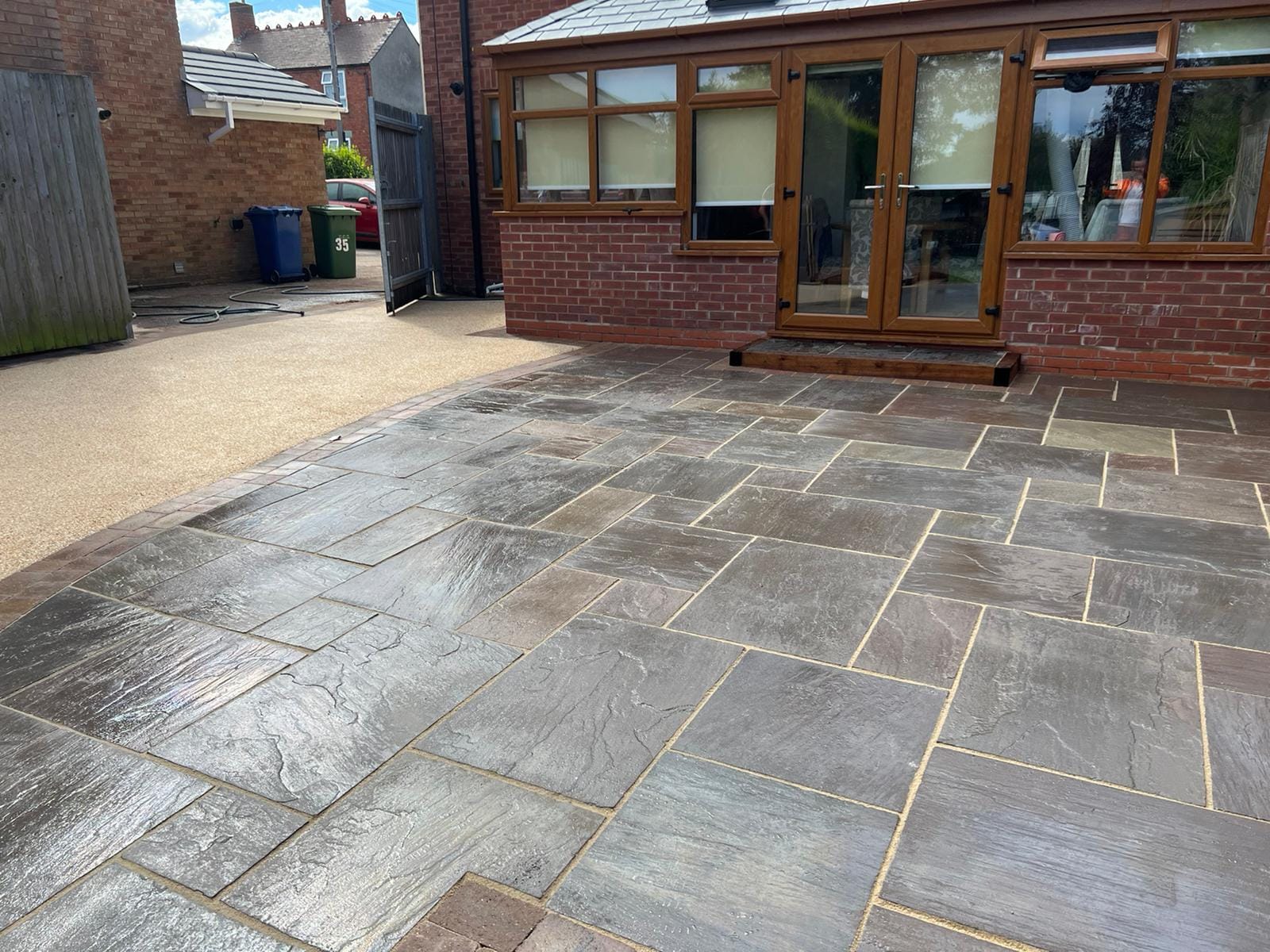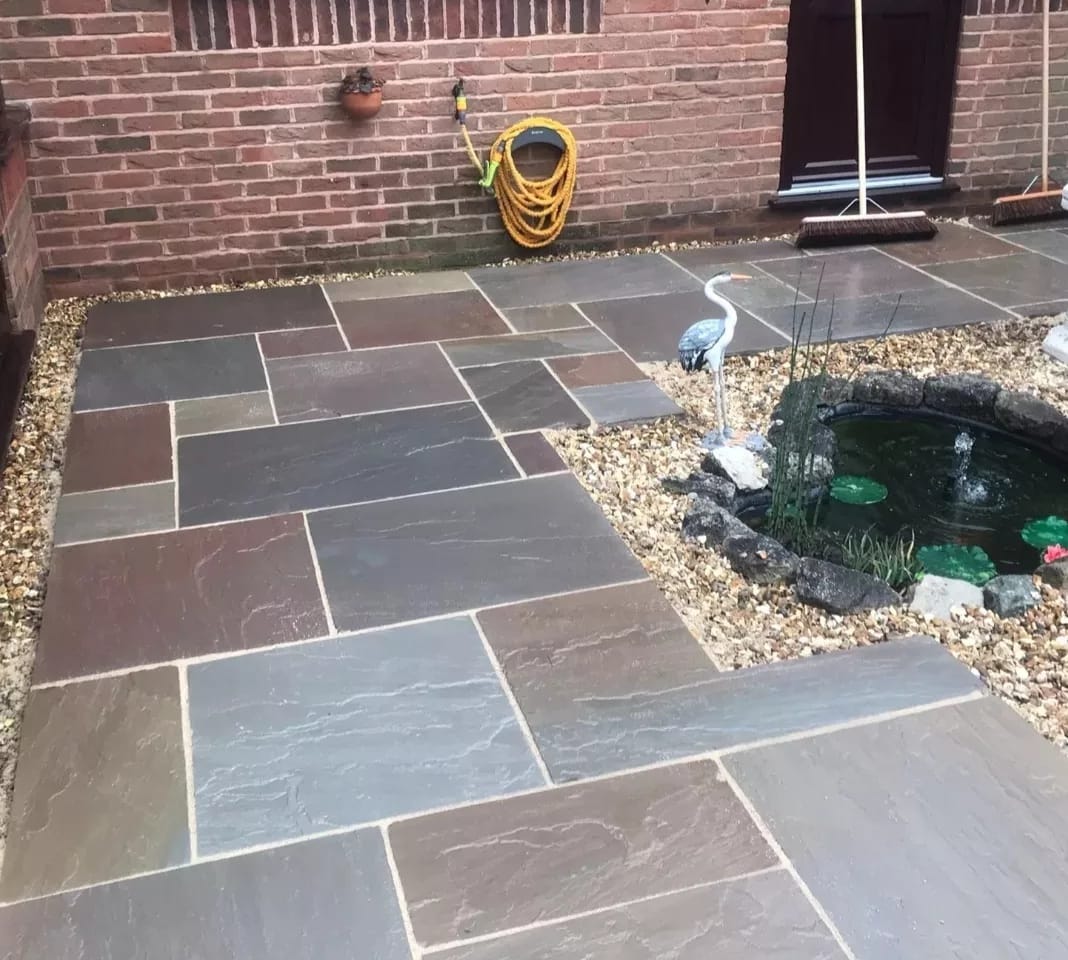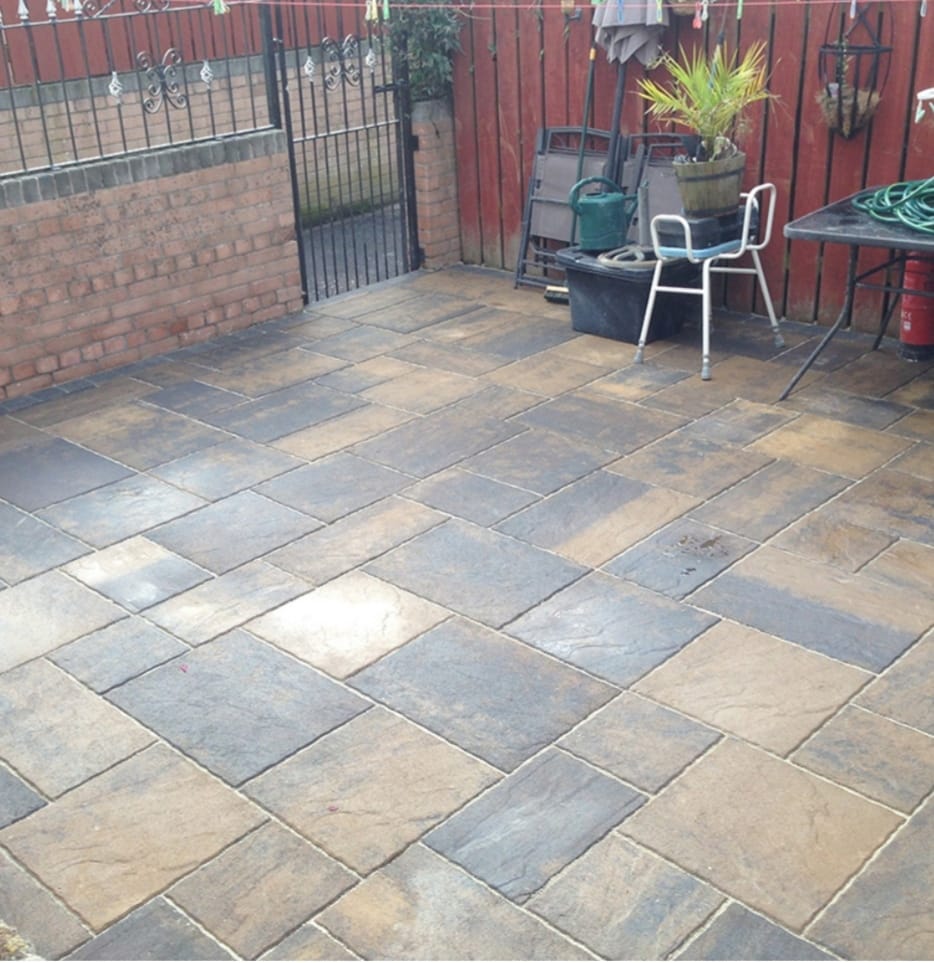Sandstone Cleaning and Maintenance
Telephone:
0115-647-1794
Indian Sandstone paving is a popular choice for outdoor areas such as patios, driveways and walkways. It's important to keep your sandstone paving clean and well-maintained to prevent it from becoming stained or discoloured.
There are a few simple things you can do to keep your Indian sandstone paving looking its best:
- Sweep or brush away any dirt or debris that has gathered on the surface. This will help to prevent staining and enable the paving to breathe.
- If you notice any moss or algae growing on the sandstone, use a stiff brush to remove it. You may also need to treat the area with a suitable fungicide.
- In order to protect the sandstone from staining, it's a good idea to seal it with a suitable impregnating sealer. This will need to be reapplied on a regular basis, depending on the amount of wear and tear the paving receives.
- If your sandstone paving does become stained, you can try cleaning it with a mild detergent and water solution. For tougher stains, you may need to use a specialist stone cleaner.
- To keep your sandstone looking its best, it's important to regularly re-sand the surface. This will help to smooth out any imperfections and restore the original colour of the stone.
By following these simple tips, you can help to keep your sandstone paving clean and looking great for many years to come.
Is sandstone paving easy to maintain?
Sandstone paving is generally easy to maintain, although it may require occasional sealing to keep it looking its best. To clean sandstone paving, simply sweep away any debris and then use a garden hose to remove any dirt or grime. If your sandstone paving has become stained, you can try scrubbing it with a nylon brush and some mild detergent. For tougher stains, you may need to use a pressure washer. Remember to always test any cleaning products on an inconspicuous area of the paving first to ensure that they will not damage the stone.

Can you pressure wash sandstone paving?
Yes, you can pressure wash sandstone paving, but be careful not to damage the stone. Use a low-pressure setting and hold the wand at an angle so that the water hits the surface of the stone at a glancing angle. Move the wand back and forth across the stone to avoid etching or damaging it. Rinse the stone thoroughly with clean water to remove any soap or cleaners that might be left behind.
Does sandstone stain easily?
Sandstone is a very porous material, which means that it can easily absorb liquids and cause staining. If you spill something on sandstone, it's important to clean it up immediately to prevent staining. There are a few things you can do to remove stains from sandstone, but it's always best to avoid them in the first place.
One way to avoid staining sandstone is to seal it with a sealant before use. This will create a barrier between the sandstone and any liquids, which will help to prevent absorption. You can also buy pre-sealed sandstone, which is ready to use and doesn't require any additional sealing.
If your sandstone does become stained, there is still hope. You can try using a poultice to draw the stain out of the stone. A poultice is a paste-like substance that you apply to the stained area and then cover with a damp cloth. The poultice will need to be left for several hours, or even overnight, before being removed.
If the stain is still visible after trying a poultice, you can try using a chemical stripper. This should only be used as a last resort, as it can damage the sandstone if not used correctly. Always follow the instructions carefully and test the stripper on an inconspicuous area first to make sure it won't damage the stone.
Prevention is always better than cure when it comes to sandstone, so it's worth taking some time to seal the stone before using it in areas where it might come into contact with staining substances. This will help to protect the stone and make it easier to clean if something does spill on it. There are many different types of sealer available, so it's important to choose one that is suitable for use on sandstone.
If you're still having problems removing a stain from sandstone, you can always consult a professional stone restoration company for advice. They will be able to assess the damage and recommend the best course of action to take.
How do you clean unsealed sandstone pavers?
One of the best ways to clean unsealed sandstone pavers is by using a pressure washer. You will need to be careful when using a pressure washer on sandstone pavers, as too much pressure can damage the stone. Start with the lowest setting on your pressure washer and work your way up until you find the right balance of pressure and cleaning power. Always test the pressure washer on an inconspicuous area before cleaning the entire surface.
Another way to clean unsealed sandstone pavers is by using a garden hose with a spray attachment. Mix together a solution of warm water and mild dish soap. Spray the solution onto the pavers and scrub with a firm bristled brush. Rinse the soap off with clean water and allow the pavers to air dry.
How do you get water stains out of sandstone?
There are a few ways that you can get water stains out of sandstone, and the best method will depend on the severity of the stain. If the stain is fresh and light, you can try to blot it with a clean cloth or sponge. For more stubborn stains, you can try scrubbing with a soft brush and mild soap. You can also try using white vinegar or lemon juice. If the stain is still there, you can try using a poultice. If the stain is very deep or set in, you may need to hire a professional to clean it.
How do you get scratches out of sandstone paving?
If you have sandstone paving that has become scratched, you can try to remove the scratches with a few simple household items. First, clean the area around the scratch with soapy water and a soft cloth. Then, using a cotton swab or small paintbrush, apply a small amount of white toothpaste to the scratch. Gently rub the toothpaste into the scratch using circular motions. Rinse away the toothpaste with warm water and dry the area with a soft cloth. You may need to repeat this process a few times to completely remove the scratch. If the scratch is still visible after trying this method, you may need to consult a professional for help.


Does sandstone lose its colour?
Over time, sandstone may lose its colour due to exposure to the elements. If the stone is not properly sealed, it can also absorb stains from dirt and pollution, which can make it appear darker. Sandstone that is regularly exposed to sunlight may also fade in colour over time.
Yes, over time sandstone will lose its colour due to weathering and erosion. The colour of the stone is caused by the minerals within it, and as these are worn away the stone becomes lighter in hue. In some cases, iron oxide can leach out of the stone and stain it red or orange.
Why does sandstone go black?
When sandstone is exposed to the air, it undergoes a chemical reaction known as oxidation. This process causes the iron in the sandstone to rust, which turns the rock black. Over time, this black layer of rust will flake off and reveal the underlying sandstone beneath.
One of the most popular types of sandstone is black sandstone, which is prized for its unique color and appearance. This stone is often used in construction projects and for landscaping purposes. While black sandstone is typically very durable, it can eventually succumb to the elements and go black. If you have black sandstone that has gone black, there are a few things that you can do to restore its original appearance.
One option is to simply clean the sandstone with a mild detergent and water solution. This will remove any dirt or debris that may be on the surface of the stone. You can also try using a power washer to remove any stubborn stains. If neither of these options works, you may need to use light sandpaper to lightly sand the surface of the stone.
Another option for restoring black sandstone is to use a sealant. There are a number of different sealants on the market, so you will need to choose one that is specifically designed for use on sandstone. Apply the sealant according to the manufacturer's instructions and allow it to dry completely. Once the sealant has dried, you should apply a thin layer of wax to protect the surface of the stone.
You can also try using a poultice to remove any remaining stains on the surface of the black sandstone. To make a poultice, mix together equal parts of flour and water until it forms a thick paste. Apply this paste to the stained area and allow it to sit for several hours. Once the paste has dried, you can simply brush it away with a soft cloth.
If you are still having trouble removing the stains from your black sandstone, you may need to resort to more aggressive measures. You can rent or purchase a power washer and use it to blast away the dirt and grime that has built up on the surface of the stone. Just be sure to follow the manufacturer's instructions carefully so that you do not damage the stone.
Once you have successfully removed all of the stains from your black sandstone, you will need to take steps to protect it from future staining. One of the best ways to do this is to apply a sealant to the stone. This will help to create a barrier between the stone and the elements, making it less likely for dirt and grime to become embedded in the surface of the stone.
If you are still having trouble keeping your black sandstone clean, you may want to consider hiring a professional cleaner. These professionals have the tools and experience necessary to properly clean and protect your sandstone. In most cases, they will also be able to apply a sealant to the stone, which will provide an extra layer of protection against staining.
How do you keep sandstone from turning black?
There are a few things you can do to keep sandstone from turning black. One is to seal the stone with a clear sealer. This will help to protect it from dirt, oil, and other contaminants that can cause it to turn black. Another option is to regularly clean the stone with a mild detergent and water solution. This will help to remove any build-up of dirt and grime that can cause the sandstone to turn black. Finally, if you live in an area with high humidity, you may want to consider using a dehumidifier in your home to help keep the air around the sandstone dry and minimise the risk of it turning black.
Why is my Indian sandstone going brown?
There are a few reasons why your Indian sandstone may be going brown. One possibility is that the stone is not sealed properly and is thus absorbing moisture and dirt from the environment. Another possibility is that the stone is not being cleaned regularly enough, and dirt and grime are building up on its surface. If you think either of these may be the case, you should consult a professional stone cleaner or restoration specialist. It's also possible that the browning is due to a chemical reaction between the stone and something it has come into contact with, such as an acidic cleaning agent. If you suspect this is the case, you should stop using the cleaning agent immediately and consult a professional for advice.
Why is my Indian sandstone going white?
As weathering occurs, the minerals in sandstone react with oxygen and water to form new compounds. This process can cause the sandstone to change colour, and it is not uncommon for Indian sandstone to turn white over time. There are several reasons why this might happen:
1) The original minerals in the sandstone may have been light-coloured or white. As they weather, these minerals may become more prominent and give the stone a lighter overall tone.
2) Weathering may cause some of the darker-coloured minerals in the stone to break down, leaving behind a higher concentration of lighter-coloured minerals.
3) The surface of the sandstone may simply become covered with a whitish powdery substance known as patina. This is caused by the leaching of minerals from the stone and is perfectly normal.
Over time, all sandstone will weather and change colour to some extent. Indian sandstone is no exception. If you love the look of your stone when it's new, be prepared for it to change over time. Just enjoy the natural ageing process and know that your stone will take on its own unique character as it weathers.
Does sandstone darken with age?
There's no definitive answer to this question, as it depends on a number of factors including the type of sandstone, the climate it's exposed to, and how well it's cared for. In general, however, sandstone does tend to darken slightly with age. This can be due to a build-up of dirt and grime on the surface, or simply from the stone absorbing more light over time. If you're concerned about your sandstone darkening, be sure to clean it regularly and seal it with a protective coating to help slow down the ageing process.


